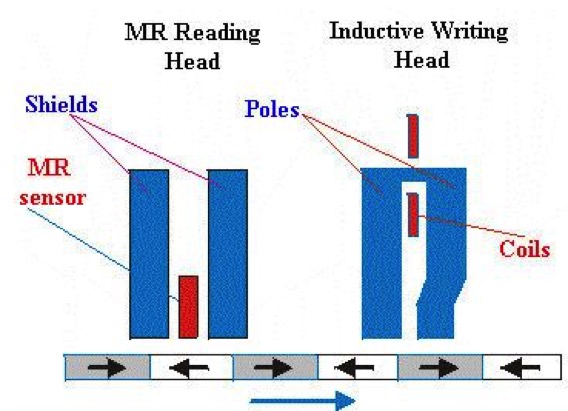History (1990): MR Read Head HDD Introduced
MR, GMR and TMR heads deliver successive increases in storage density.
This is a Press Release edited by StorageNewsletter.com on May 18, 2018 at 2:20 pmThis article comes from the Computer History Museum.
1990: Magnetoresistive read-head HDD introduced
MR, GMR & TMR heads deliver successive increases in storage density
MR Read Head with Inductive Write Head

(HGST)
In 1856, William Thomson (Lord Kelvin) discovered the phenomenon of anisotropic magnetoresistance (AMR) in which a changing magnetic field induces a resistance change in a conductor.
Based on a proposal by R. P. Hunt of Ampex, IBM produced the Model 3660/3663 Point-of-Sale system with an AMR magnetic stripe reader in 1975.
As the readback signal from an MR head can be much larger than that from an inductive head of the same size, in 1984 IBM introduced the Model 3480 magnetic tape storage unit with an MR read element added alongside an inductive write element to form a merged read/write head.
IBM San Jose adapted the technology for a hard disk drive unit code named ‘Sawmill’ that shipped in the IBM 9345 DASD system in 1990. Sawmill had an areal density of 107Mb/square inch.
In 1991, head and disk improvements in the IBM Corsair HDD raised the number to 132Mb/square inch. Corsair heads and disks were slightly improved versions of Sawmill components.
In 1994, Fujitsu, Hitachi, and Hewlett Packard independently developed MR heads.
HP licensed the technology to Dastek (later Headway-TDK) for merchant market sale.
Giant magnetoresistance, discovered by Albert Fert and Peter Grunberg in 1988 (recognized by the Nobel Prize in Physics in 2007), relies on alternating layers of atomically thin magnetic and non-magnetic conductive materials. The Information Storage Industry Consortium (INSIC) led a research program on GMR heads and in 1997 IBM introduced the ‘spin-valve’ GMR head with an areal density of 1Gb/square inch in a 16.8GB drive for the Deskstar 16GP personal computer.
John Slonczewski proposed in 1974 that magnetic tunnel junctions could be used as a ‘Magnetic Gate.’ Tunneling magnetoresistance (TMR) involves electrons moving through an insulating barrier between magnetic layers resulting in a relatively large resistance change between the parallel and anti parallel orientations of magnetization.
TMR heads achieving an areal density of 84Gb/square inch were introduced in 2004 in the Seagate Momentus II, 2.5-inch, 120GB HDD.
Manufactured with thin-film technology, these three generations of MR heads in combination with PMR disks substantially contributed to the achievement of an areal density of 1Tb/square inch by 2014.













 Subscribe to our free daily newsletter
Subscribe to our free daily newsletter

